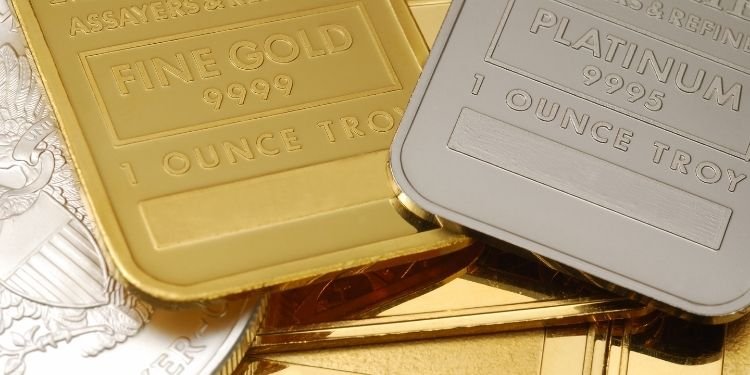Platinum and gold have long been viewed as valuable precious metals, but a curious phenomenon has been observed in recent years: platinum is often priced lower than gold. Historically, platinum was considered the more valuable metal, but the tables have turned. What changed? In this article, we’ll explore the key factors that have led to platinum prices being lower than gold and provide insights into the current trends driving the difference.
PLATINUM Is Cheaper Than GOLD! Why Is That?
Open a FREE Bullion Vault account today with no obligation to trade! BONUS: Sign up now and receive a risk-free 1/8 oz (4g) of silver to kickstart your journey into precious metals investing

1. Platinum vs. Gold Price Difference: Historical Perspective
Why platinum is cheaper than gold today is a question that stems from recent economic changes. Historically, platinum was rarer and more expensive than gold, largely due to its limited availability and industrial demand. It was considered the “king of metals” because of its rarity, use in high-end jewelry, and important industrial applications, especially in the automotive sector.
However, over the last decade, there has been a platinum price drop vs. gold price rise, reversing this trend. Gold has taken the lead as the more valuable metal. To understand why this happened, we need to delve into factors like supply and demand, industrial applications, and geopolitical shifts.
2. Supply and Demand: Why Platinum Costs Less Than Gold
The supply and demand dynamics for platinum and gold play a significant role in determining their respective values. For one, platinum is rarer than gold but is more dependent on industrial demand. Platinum mining is concentrated in a few locations, primarily South Africa and Russia, making the supply chain vulnerable to disruptions. However, demand has fallen in recent years due to advances in technology and changing regulations.
Gold, on the other hand, enjoys more consistent demand, not just from industries but also from investors. Why gold outperforms platinum in value can largely be attributed to gold’s status as a safe-haven asset, particularly during times of economic uncertainty. Investors flock to gold during economic downturns, driving up its price.
3. Industrial Demand: Impact on Platinum Price
The platinum vs. gold price trends can also be attributed to how these metals are used in different sectors. A large portion of platinum demand comes from the automotive industry, where it is used in catalytic converters to reduce emissions. Over the past few years, the shift to electric vehicles, which do not require platinum-based converters, has reduced demand. This change in the automotive industry has had a significant impact on platinum prices.
Conversely, gold has a more diverse range of applications. It’s used in electronics, jewelry, and investment products, and it has cultural and historical significance, especially in Asia. The fact that gold is more valuable than platinum can be traced to its wide range of uses, making it less vulnerable to shifts in a single industry.
4. Geopolitical Factors and Economic Trends
Geopolitical factors and economic shifts play a major role in why platinum prices are lower than gold today. Platinum’s supply is more susceptible to disruptions because of the geopolitical stability in key mining regions like South Africa. Political unrest, labor strikes, and regulatory changes can cause supply chain bottlenecks, making platinum a riskier bet for investors.
Meanwhile, gold has maintained its role as a store of value, a status it has held for centuries. Investors perceive gold as a stable investment, particularly during inflationary periods. The rising demand for gold from central banks and large-scale investors has kept its price strong even during times of economic upheaval.
5. Why Gold Is More Valuable Than Platinum: Investment Demand
One of the primary reasons why gold is more valuable than platinum is the demand from investors. Gold has always been viewed as a hedge against inflation and economic instability. In times of crisis, investors turn to gold to protect their wealth. This demand has surged over the past decade, particularly with the global financial crisis, ongoing political tensions, and inflation concerns.
Platinum, on the other hand, is less frequently used as an investment vehicle. Its price is closely tied to industrial demand, making it more volatile and less appealing to those looking for long-term investment opportunities. The factors affecting platinum prices are much more influenced by industrial trends, while gold’s value is more stable due to its historical reputation as a secure investment.
6. Supply Chain and Market Perception
The supply chains for platinum and gold are quite different, and this has an impact on platinum price lower than gold reasons. Gold is mined in more countries, making its supply chain more robust. Platinum mining is concentrated in fewer regions, making it more prone to supply disruptions. This uncertainty is another factor that reduces its appeal compared to gold.
Additionally, why platinum prices are lower than gold has to do with market perception. Gold is universally seen as a symbol of wealth and stability, and it plays a significant role in currencies and international reserves. Platinum does not hold the same universal value. While platinum is admired for its beauty and industrial uses, it lacks the deep-rooted cultural significance that gold has across many regions of the world.
7. Environmental Regulations and Technological Shifts
Environmental regulations have shifted significantly over the past few decades, especially with the push for greener energy and reducing carbon emissions. This has had a notable impact on why platinum is worth less price than gold. As countries transition away from fossil fuels, the demand for platinum, which is heavily used in catalytic converters, has decreased. The rise of electric vehicles has further dampened the demand for platinum in the auto industry.
Gold vs. platinum in this context highlights the flexibility of gold as an asset. Gold has managed to retain its value despite industrial changes because its primary demand comes from investors, central banks, and consumers, particularly in the jewelry sector.
8. Future of Platinum and Gold Prices
Looking forward, will platinum price trends reverse, or will gold continue to dominate? The future is uncertain. The shift towards greener technologies may continue to impact platinum demand negatively, especially if electric vehicles become more widespread. However, if new industrial uses for platinum are discovered, it could see a resurgence in price.
Gold, meanwhile, is likely to continue to be a cornerstone of wealth preservation for both individual and institutional investors. As inflation fears persist and economic uncertainties loom, why gold outperforms platinum in value will likely remain a relevant question.
Conclusion
In summary, the factors affecting platinum prices compared to gold stem from several key influences: supply and demand dynamics, industrial applications, geopolitical stability, and market perception. Why platinum is cheaper than gold today has much to do with its reliance on specific industries and its vulnerability to market disruptions. Gold’s diverse applications, historical significance, and role as a stable investment make it a more valuable asset in the current economic climate.
While platinum remains a highly valuable metal, its fate is more tied to industrial shifts and technological innovations. Gold, on the other hand, continues to hold its place as the metal of choice for investors looking for stability in an uncertain world.
Open a FREE Bullion Vault account today with no obligation to trade! BONUS: Sign up now and receive a risk-free 1/8 oz (4g) of silver to kickstart your journey into precious metals investing






Comment